Patrick Sebile (who many say is the world's most
accomplished angler), Laurent Picq, a famous angler from France
and Russ Bassdozer trolled, retrieved and jigged over 70 stripers
in Warm Creek Bay on Lake Powell, Utah yesterday. The day
earlier, we landed plenty of fine largemouth, smallmouth and even
walleye, yellow catfish and carp succumbed to Sebile lures during
our two day test trip on November 15 and 16, 2009.
The first day, we started fishing in backs of
canyons called Labyrinth, Gunsight, Rock Creek and Padre, with
high hopes of laying into bass and stripers in those arms. We
certainly did okay, but not great. Best was Rock Creek. Patrick
had some lures he wanted us to test (he is the owner/designer or
Sebile lures), and bass obliged by hitting a variety of them
including:
-
Magic Swimmer 110 Fast-Sinking jointed
swimbait, with which Laurent landed our best bass of the trip - a
nice smallie in Gunsight.
-
Flatt Shad Snagless. This a lipless
vibrating crankbait that can be pulled through the thickest brush
or weed cover anywhere and hardly ever snags, which is exactly
how Patrick snagged a couple nice bass nestled in brush beds in
Rock Creek. It has a hookless feather tail, and an upward-facing
double (not treble) hook on the belly that tucks up tight to the
bottom. The broad flat sides of the lipless bait serve to shield
the hook from everything the lure encounters except for striking
fish which get solidly hooked.
-
Koolie Minnow 90 LL in white proved best
for bass this day. It looks like a jerkbait minnow, but I swam it
steadily through the brush like a crankbait, not jerking or
pausing it. The Koolie has a bowed body and a very broad, flat
belly that shields the trebles from snags, so it comes through
brush amazingly snagless, which is how I landed a handful of nice
smallies and largemouth in the brush in Rock Creek.
-
Stick Shadd Hollow soft bait was what
Patrick also dropshot a bass or two in the deep brush in front of
the Cookie Jar in Padre Bay.
The bass fishing was decent but truly, we were
hoping for a little more action and size than we had. On the way
home, I pulled into Warm Creek basin at last light in order to
scout for the striped bass that I know always winter-over in
there. I put the boat down about 1/2 mile from the back on the
eastern shoreline (which gets the late light), idled onto the 60
foot mark, and immediately found big dense walls of shad and
striper schools blacking out the fishfinder. By the dense,
compact and fairly featureless blobs of bait and predators, we
knew they were not actively feeding right then, but we dropped a
few spoons down, and pulled up a couple stripers, confirming this
would be where we'd start the next morning's fishing for
stripers.
The second day morning, we got to Warm Creek bay
about 8 o'clock and started marking and fishing the thick black
balls of fairly inactive fish on the graph. In the morning, most
of the bait and stripers were in water from 80 to 60 feet deep,
and there was also a significant presence hovering over depth
breaks (rapid changes in bottom depth) down to 100 or more feet
deep.
We started to jig a few stripers, mainly from the
60 to 70 foot schools, but it was difficult to keep the boat over
the schools. Although fish were coming aboard on a steady basis,
we spent as much time idling around as fishing. So I reckoned
that if we couldn't easily stay on the schools, we would instead
bring the schools to us by trolling, retrieving and then jigging
them.
It wasn't any one technique - but the combined
effect of trolling, retrieving and jigging that started scoring
striper after striper for us from the late morning and lasting
through 2:30 pm.
What I mean by our devastatingly effective
trolling, retrieving and jigging combo is the following
explanation:
-
First, we trolled 1 oz Koolie Minnow 118 LL
plugs about 60 yards behind the boat on the thinnest braided line
possible. Patrick had a wispy thin 12 lb test braid that was
letting his Koolie hit bottom about 43 feet deep. So we put
Patrick's line down the center behind the boat, in between
Laurent's and my line. I had a thicker 20 lb braid and was only
achieving 34 feet of depth due to the thicker line diameter.
Laurent also had a thicker braid, and he wasn't achieving the 40+
foot depths, only Patrick. We mainly trolled the 50 to 60 foot
depths since by late morning, the stripers and bait had moved
shallower from 60-80 feet in early morning to 50-60 feet deep by
late morning, and the dense balls of bait and predators had
started to open up (were not as densely compacted) by late
morning, meaning they were becoming more active.
-
Because Patrick's plug was reaching 40+ feet deep
(due to his ultrathin line diameter), he was hooking almost all
the fish as we trolled, using the big motor at idle speed (800
rpm's). I'd start marking fish on the graph, and a few seconds
later, Patrick was most likely to hook up. But that didn't mean
Laurent and I were shut out. It's true we did not hook many on
the trolling phase, but once Patrick hooked a fish out of the
school, we'd shut off the motor right away. This is where phase
two - retrieving - our plugs so they followed and flanked
Patrick's hooked striper resulted in multiple hook-ups for
Laurent and I. We had 60 yards of line out behind the boat, and
as Patrick fought the first fish, he'd pull the school up to the
level where Laurent and I had our plugs as we retrieved them on
both sides of Patrick's fish - and we'd also hook up.
-
Now, 2 or 3 of us were hooked up on plugs, and
bringing the entire school to the boat along with the hooked
fish. The school would come right up to the top by the time they
were boatside, and you could simply cast back out and catch
another one or two near the surface for a minute as we boated the
hooked fish.
-
Next, we'd drop 1.4 oz Fast Cast 42 jigging
spoons down on the school, now under the boat, and this was
almost like chumming with the jigging spoons constantly being
jigged up about 8 feet and then falling back down (which is when
most bites occur). With three spoons, it simulates a fall-out of
injured shad fluttering to the bottom thereby keeping the school
under us for a few minutes more. All of the fish were super fat
and their stomachs were stretched to the bursting point with
shad. They looked like stomachs with tails and fins. By 1
o'clock, the feeding activity was so high, that the streaking
fish on the graph looked like Fourth of July fireworks exploding
beneath the boat, and most of the stripers were so stuffed by
this time that they regurgitated fresh mouthfuls of both gizzard
and threadfin shad - about the size of our spoons - further
chumming the water to keep the schools with the boat. We also
caught stripers on Sebile's 2.1 oz Vibrato wacky jigging
spoons and 1-1/4 oz Spin Shad #2 tailspinners, plus,
when the fish moved shallower than 40 feet and into its effective
range, we caught a few by vertical jigging the 3/4 oz Flatt
Shadd 66 XH (Extra Heavy) lipless crankbait - but it's fair
to say that the 1.4 oz Fast Cast jigs in a variety of shad colors
were the most effective vertical jigging tools for us this
particular day.
By 2:30, we got into the biggest, most active
school, that stayed under the boat for fifteen minutes, and we
caught them on almost ever drop of the spoon as the boat drifted
from 60 to 30 feet deep, with constant double and triple
hook-ups. It was our finest moment! Marks on the graph were no
longer dense blobs, but more like streaking, scattered markings,
surely signaling that an all-out, furious striper blitz was going
on below. The scent of battered shad wafted to the surface, and a
sweet smell of shad oil spread over the water, filling the warm
air all around us.
I am not sure if the school moved with us, or if
we slowly moved over them, since as we got shallower (from 40 to
30 feet), the fish got smaller. Most of the fish all day were 3
to 5 pounders, but as we drifted over the shallowest tip of this
school (about 30 feet deep), there were only 1-2 pounders. So I
think that was just a solid 15 minute long school that we slowly
slid over. There was no wind at this time, and we were fishing
off the deep side of the boat, so as 2 or 3 of us were always
hooked up, the fighting stripers were actually working like mule
teams to pull our boat back toward the main melee, helping to
pull and position the boat right over the heaviest action!
Also note that when the stripers were deepest and
least active early in the morning, they had a pale purple blush
and very dark black stripes. As they became semi-active in late
morning, the blush had flushed to a brighter pale blue. At the
height of the feeding frenzy after noon, the charged-up fish were
flashing a pale green, a more silvery sheen and dark chocolate as
opposed to black stripes.
All good thing must end, and around 2:30 pm, a
slight breeze arose out of the south, which riffled the surface.
The fresh breeze was just strong enough to finally blow the boat
off that massive school and into shallow water. Since we were
almost up on the shoreline by this time, we turned around and
started casting to shore, which was how Patrick landed a nice
walleye on the Koolie Minnow 118 LL, and we also had some other
bites from bass - but didn't land them.
I am not sure whether it was us or the stripers
who had enough, but whoever gave up the game by 2:30 pm, we
didn't catch or mark many more stripers after that. I honestly
think it was us, the anglers who were finished catching for the
day. I feel the stripers continued feeding, but had moved to the
sunniest side (the east side) of the bay, which was where we
first found them the evening earlier. I find the stripers will
often lay on western shorelines when the sun is in the eastern
sky and on eastern shorelines after 2 pm on sunny winter days. I
do think they moved over to the eastern shoreline, but we did
not. We had a dinner date that we didn't want to miss that
evening at the home of Jarrett and Becca Edwards who produce the
“Jarrett Edwards Outdoors” TV show. They feature
multi-species catch and release action on the most famous waters
of the western USA. Their show is high tech, specializing in live
underwater diver videography, scenic helicopter aerial shots and
multi camera production. Jarrett's show airs nationally on The
World Fishing Network, Dish HD Channel 394.
So we left Warm Creek around 3:30 pm with a
cooler full of stripers to fillet, and a great day we won't ever
forget, made even more memorable with a scrumptious home-cooked
dinner by Becca with friends!
If you want to try for these stripers, it was
difficult but not impossible to put it all together like we did
yesterday. These stripers that always winter-over in Warm Creek
won't come to lures as easy as during the summer months, but hard
work will pay off all winter. Key this trip was the 60 foot
depth, and out deeper than that in the morning, shallower than
that in the afternoon. Simply motor straight back into Warm Creek
until you are in the very back where the depth comes up to 60
feet, which will form an imaginary line from one side of the
basin across to the other side, at the 60 foot depth. This is
your key depth for now. Then pivot the search up along that 60
foot mark for about a 1/2 mile on either side, keying off the
mouth of the deep slot creek on the east side, across the back of
the basin to the western shore (up to the brushy creek mouth).
Toward the tail end of the day, or first thing in
the morning, try the east side from the deep slot creek up about
a 1/2 mile to where we found the original school at last light of
the earlier day.
Keep this trip report in mind and hopefully you
too can keep a tight line deep into a Warm Creek striper blitz.
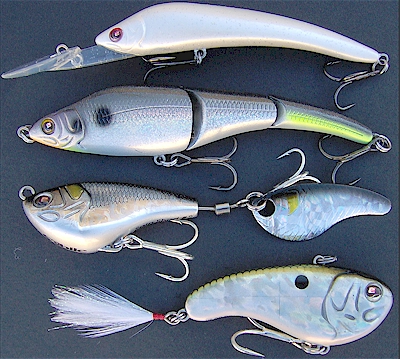
Bass lures that worked on day one, from top down: 3/8 oz Koolie
Minnow 90 LL (Long Lip), 3/4 oz Magic Swimmer Fast-Sinking
jointed swimbait, 1-1/4 oz Spin Shad #2 tailspinner and 1/2 oz
Snagless Flatt Shad 66 SK (Sinking) lipless crankbait.
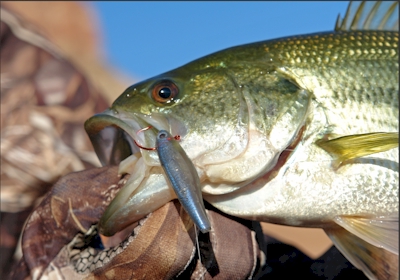
Stick Shadd Hollow soft bait on dropshot also produced a few bass
in deep brush.
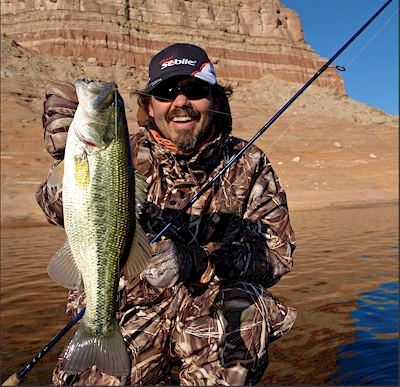
Patrick smiles over fine bass on Stick Shadd Hollow dropshot.
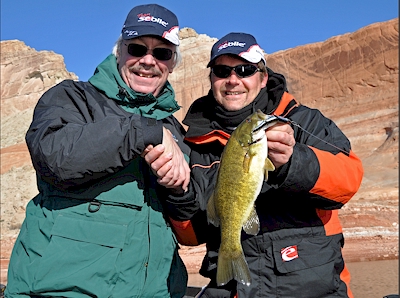
Russ and Laurent shake on smallie on Magic Swimmer 110 Fast
Sinking jointed swimbait.
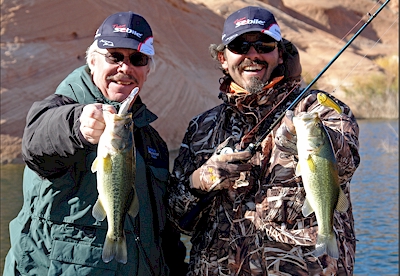
Russ with bass on Koolie Minnow 90 LL. Patrick matches with
Snagless Flatt Shad 66 SK lipless.
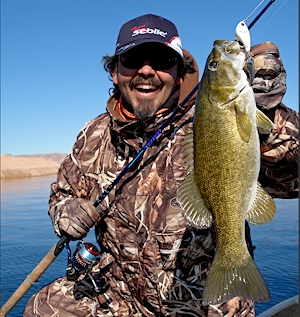
1-1/4 oz Spin Shad #2 tailspinner produces another fine smallie
for Patrick.
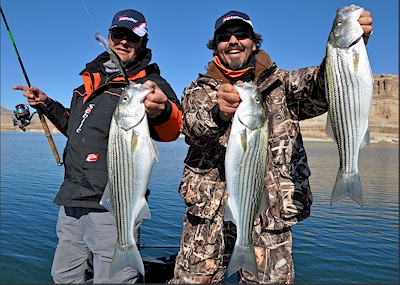
Fast action with stripers filled day two with plenty of double
and triple headers.
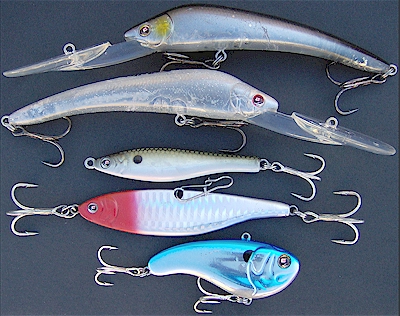
Effective striper lures from top down: pair of 1 oz Koolie Minnow
118 LL (Long Lip), 1.4 oz Fast Cast 42 jigging spoon, 2.1 oz
Vibrato 60 jigging spoon and 3/4 oz Flatt Shadd 66 XH (Extra
Heavy) lipless crankbait. Also, 1-1/4 oz Spin Shad #2 tailspinner
(not shown).
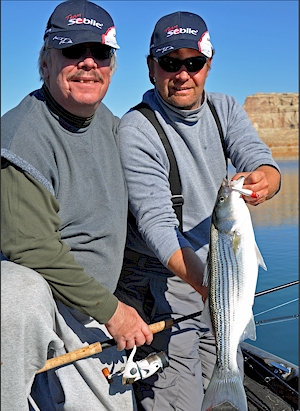
Russ and Laurent with fish on 1.4 oz Fast Cast jig.
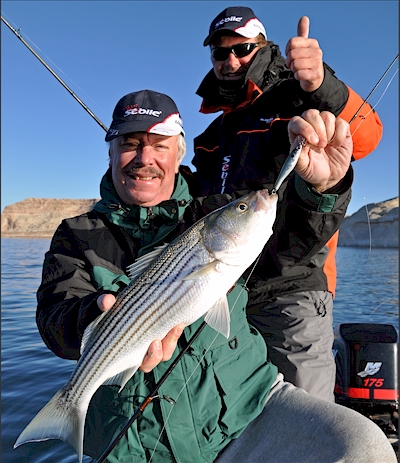
Thumbs up for another Fast Cast jig fish!
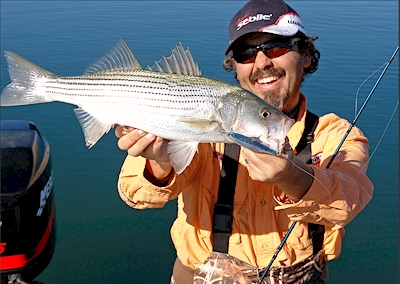
The 2.1 oz Vibrato wacky jig produces for Patrick.
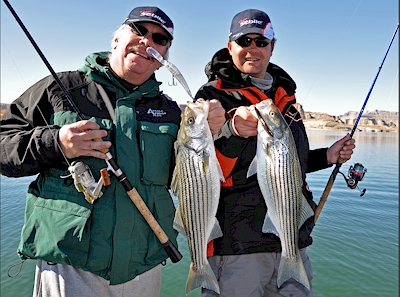
Double for Russ and Laurent trolling and retrieving 1 oz Koolie
Minnow 118 Long Lips
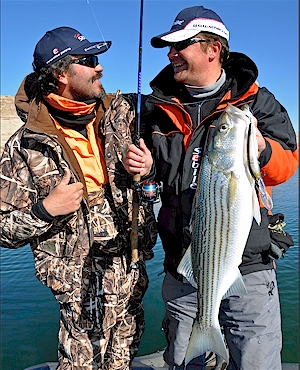
Patrick and Laurent chuckle over trolling deep (34 to 43 feet)
with Koolie Minnow 118 LL.
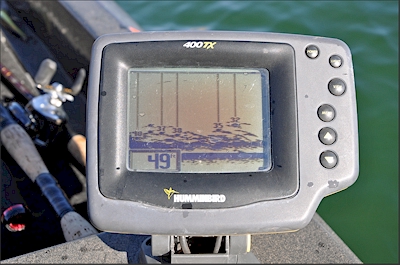
Screen fills with charging stripers from 32 to 49 feet below the
boat.
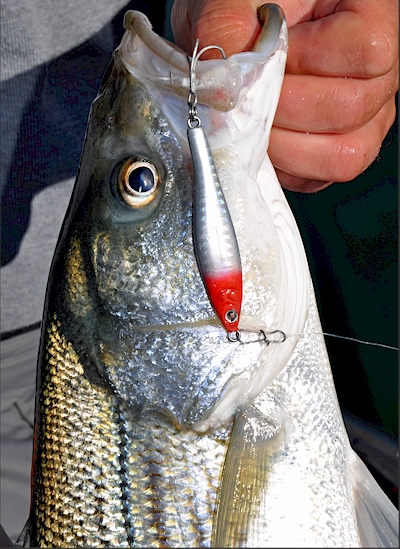
1.4 oz Fast Cast 42 jigging spoon proved devastatingly effective
on stripers.
Striped Bass Fishing Fun on Lake Powell
August 2009 with Patrick
Sebile and Capt. Jay Withers
What do a trio of guys who work in the fishing
business do for fun? We just can't help it. We confess. We love
to go fishing more than anything else!
This time we shot forty-two miles up lake in the
cool dimness of false dawn, itching to reach a hotspot nestled in
the back of Rock Creek Canyon on Lake Powell in Utah. Fish had
bitten well there on Thursday, when a lot (approx. 50 stripers)
were deep-jigged off bottom. We were disappointed there on Friday
morning, when "only" 8 to 10 stripers obliged us. On
Saturday, the wind blew them off their feed. So with two
"off" mornings in a row, as we sped back up there on
Sunday morning, I just knew (I hoped) that they'd be ready to go
wild in the windless conditions on Sunday morning - and they did!
Patrick Sebile, a Frenchman who has relocated
himself and his lure company to Palmer Lake, Colorado supplied us
with some new lures we were field-testing for him. Patrick's
possibly the best angler in the world today.
Also joining us was Captain Jay Withers, a
saltwater charter captain sharpie from Port Charlotte, Florida.
We hit stripers and smallmouth on Sebile's new
lures, which will be available in late 2009 or early 2010. I'm
here to tell you, you need to try them too! The hit list
included:
-
New Fast Cast Jig.
An ideal choice for distance casting, speed reeling and jigging
bottom in deep water.
-
New Vibrato Jig.
I can only describe the Vibrato as a wacky jig, with the line
tied to the center of the long, slim metal jig's body, and a
treble dangles off each end of the bait. On the fall, it flutters
like a wacky worm, and when you lift it, it paddles hard,
vibrating side-to-side with a throbbing resistance felt in the
rod tip. There's really nothing else quite like it
-
New Spin Shad #1.
We fished the smallest of the Spin Shad sizes from anywhere just
below the surface to sixty feet deep, and caught stripers
non-stop with it. The Spin Shad was also the most productive lure
for smallmouth on this trip.
-
New
Crankster SR (Shallow Runner). We didn't use this a
lot, but when we did, stripers and smallies were all over it!
-
Slim Stick and Splasher
Topwater Baits. These aren't new (although many
anglers have yet to try them) - but it was too much fun for us
not to toss them for stripers and smallies on top!
-
New Magic Swimmer Soft
and new Stick Shadd Soft. We Carolina-rigged and
dropshot these new soft lures, having success with smallmouth -
but that's another story. Let's take it back to the big striper
blitz right now...
So there we were - battling schoolie-sized
landlocked striped bass. At times on every cast all three of us
were reeling them in - reveling in the world-famous beauty of the
scenic southwest desert impoundment, Lake Powell.
As the sun and temperature climbed quickly and
uncomfortably, the stripers retired for the day to parts unknown.
After the striper action subsided, we did try largemouth and
smallmouth fishing, which was slow, but the poor cooperation from
the black and brown bass didn't dampen our delight or tarnish our
shared memories of catching the plentiful striped bass that were
breaking the surface in an early morning feeding frenzy. At times
they surrounded us in all directions for magical moments that
didn't want to end. The barrages of feeding stripers everywhere
were amplified and echoed off the cliff walls, seeming all the
louder in contrast to the stillness of early morning.
Differences Between Freshwater and Saltwater
Stripers
People often ask if there are differences in the
quality of the fight, the coloration, body tone, or if stripers
taste different from fresh or saltwater. No, there really is no
difference I can notice.
One thing though, is that freshwater stripers
fixate or predate heavily on pelagic (meaning open water
baitfish) in large impoundments like Powell. They do not normally
pursue bottom fish, mollusks, panfish, crayfish for example,
unless pelagic baitfish (like shad) become so scarce or
inaccessible that the freshwater stripers really have no other
choice but to scavenge for anything else they can find, which
doesn't happen that often. Fortunately, they can usually find
shad, shad and more shad. It's their mainstay on Powell.
In contrast, in saltwater, it seems there is such
a multitude and variety of bait available to striped bass, that
they tend to feed on whatever's most plentiful at any given
moment, which may vary widely. What this means to an angler, is
that saltwater striped bass will often hit a wider variety of
lures, especially colors that match whatever fodder's most
prevalent at the moment. Sometimes that may be red-hued sand
eels, golden yellow baby pollack, amber brown squid,
black-striped mackerel, sheening butterfish, black eels, blue
herring, not to mention shrimp, clams, crabs, worms, bottom fish
(baby blackfish, porgies, flatfish) snapper blues, hordes of
young-of-year weakfish and so much more. Now, it’s true that
day in and day out (including night fishing for stripers), odds
are you can't beat a white color lure for saltwater stripers -
but since the menu is so varied in saltwater, other colors seem
to be of more importance in the salt to match the almost endless
menu in the seas. Conversely, since the menu is so limited in
freshwater impoundments like Powell, basically to shad, the
importance of a white color lure is absolutely essential, such as
the Sebile White Lady (Q2) color in freshwater. Certainly have
fun trying other colors, but white really is the "go
to" color for freshwater stripers, plus shad-imitating
silver-sided colors like Sebile's Holo Greenie (D9) and Natural
Shiner (O) for instance.
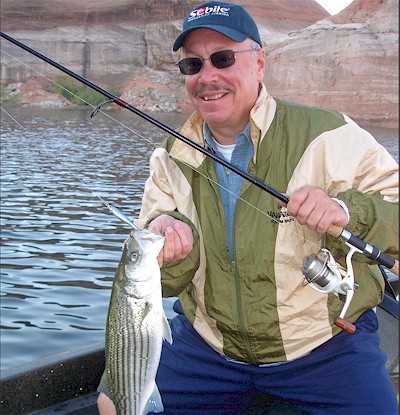
Russ lips one on Sebile's Fast Cast jig.
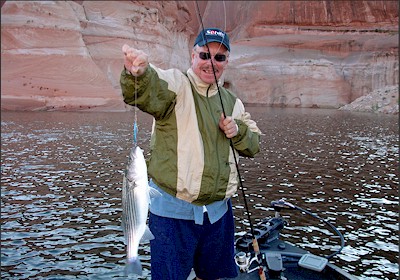
Bassdozer hoists another on flashy blue sardine color Fast Cast
jig.
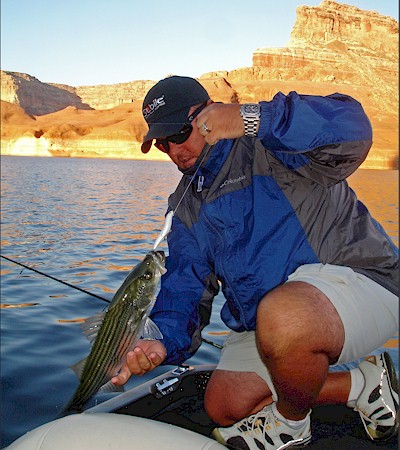
Capt. Jay had much success by "walking the dog" with
Sebile's Slim Stick topwater bait in White Lady color.
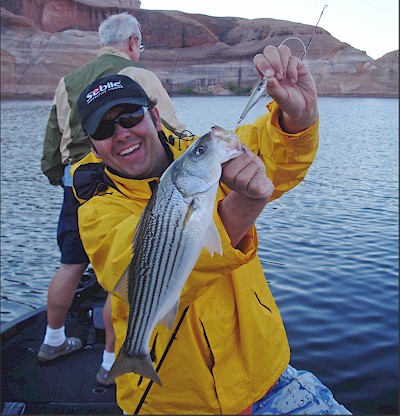
Patrick Sebile demonstrates effectiveness of his new Fast Cast
long distance casting jig in Holo Greenie (D9) color.
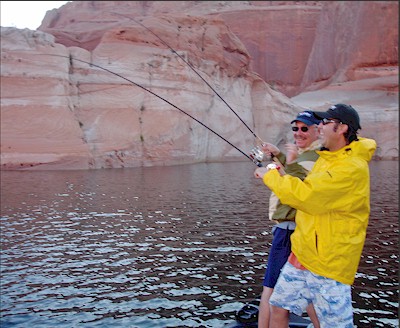
Patrick Sebile and Russ Bassdozer chuckle gleefully over a double
whammy of bent rods and hard-fighting stripers!
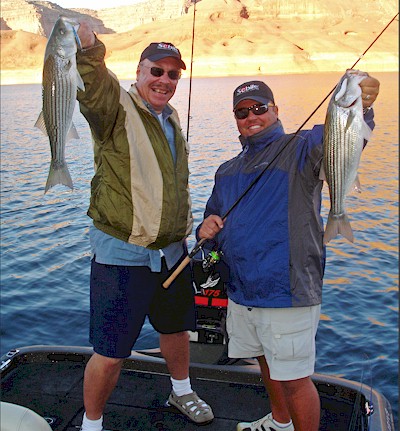
Russ and Jay wax victorious again!
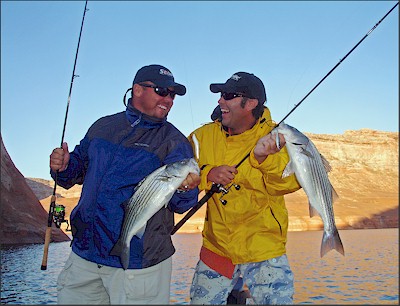
A good time was had by all!
After stripers schools had broken up the shad
schools and pushed the remaining shad up against offshore reefs
or deep cliff walls, then schools of smallmouth would come out to
clean up on the left-over shad.
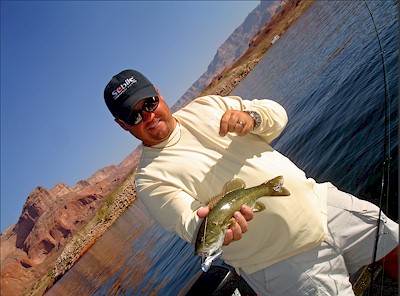
Captain Jay pops up a little smallmouth on the side with a Sebile
Splasher topwater lure.
When the stripers schools took breaks (which
didn't last long) to let the dispersed shad regroup back into
schools before charging them again, that's when smallmouth would
come out from the nearby reefs, points and walls and blast
anything that moved, including a blue chrome Sebile Crankster SR
(Shallow Runner) fat crankbait waddled along the surface with a
stop-and-go retrieve. Swim the Crankster SR barely below the
surface for several feet and then let it pop to the top during
pauses in the retrieve, which is when smallies love to smash it.
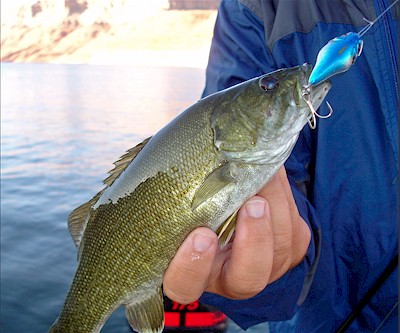
Following are examples of the new products we put
to the test, producing results that exceeded our expectations.
What a memorable and rewarding trip this was for Patrick, Jay and
I!
New
Crankster SR (Shallow Runner) has a super-loud
knocking rattle inside, and casts super long distance. It waddles
desperately just under the surface. Try pauses every few feet to
let it pop to the top, then continue.
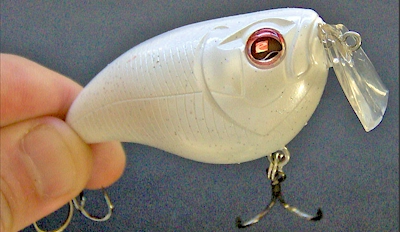
New
Spin Shad #1 (shown top) weighs 5/8 oz. This is the
size we used from just below the surface to 60 feet deep - and at
any depth in between wherever striper schools showed up in
mid-water on the electronics, we were able to count down and keep
the Spin Shad #1 working at any level necessary in the water
column. We did not get a chance to try Spin Shad #2 (bottom)
which weighs 1-3/8 oz and is easy to use, according to Patrick
and Jay who have fished depths to 120 feet with it - which is not
uncommon for striper fishing or offshore ocean fishing.
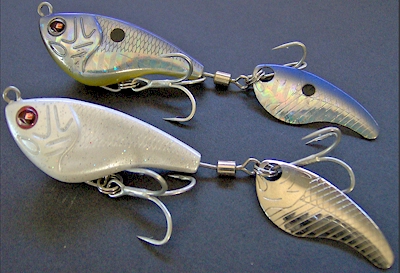
New
Vibrato Jig, which I refer to as a "wacky-rigged
jig" since the line is tied mid-center, remindful of how one
rigs a wacky worm, except this is a solid metal jig. It flutters
on the fall and throbs with vibration when you lift or jig it.
Stripers and smallies hit it on the fall as well as on a steady
retrieve or when bounced on bottom. On a steady retrieve, I used
it like and it felt like a tight-wobbling crankbait. It worked
any way I tried to use it!
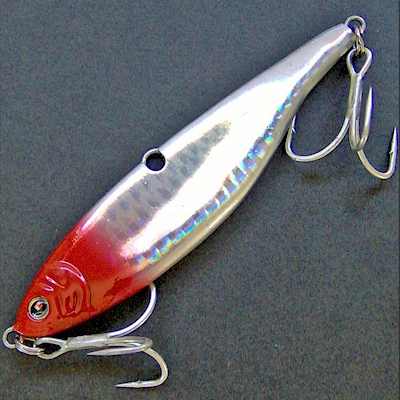
New
Fast Cast Jigs. These metal-bodied beauties weigh
approx. 1-3/8 oz and are 2-3/4" long, but will come in
larger and smaller sizes too. They're great for long distance
casting, they swim and swagger on the retrieve and excel for deep
vertical jigging. The Fast Cast proved productive on stripers and
smallies alike.
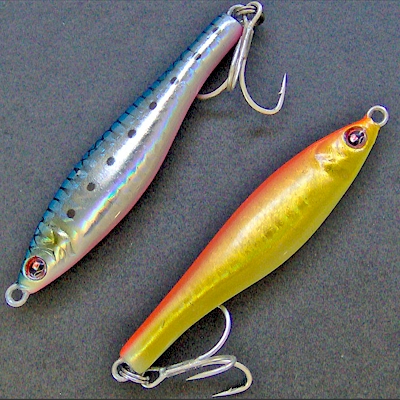
|
Bonus Story: Mixed
Catches Don't Mean Mixed Schools
|
|
I have far more time and experience in saltwater with striped
bass than I do in freshwater with largemouth or smallmouth. But
fresh or salt, mixed catches of gamefish don't mean mixed
schools. I haven't really known gamefish schools to mix freely.
True, on the trip above, we caught a mixed bag of stripers and
smallmouth, but the species were not mixed into a homogeneous
multi-species school of gamefish.
They all just happened to be after the same prey
in the same area. Yes, the smallies were taking advantage of the
stripers' hard efforts in corralling and pushing bait toward the
waiting smallmouth, but they were not mixing into a multi-species
gamefish school.
Often, largemouth and smallmouth bass will
uncannily anticipate where the stripers will push bait, and will
line up and be waiting on strategic spots on structure or in
cover for that striper bait push to happen - the bass jockey for
prime positions even before the stripers start to get active.
It's like waiting for a parade to come down the street. The bass
somehow anticipate the striper push will come their way, and it
usually does!
Also, bass will become active below, on the
perimeters of or immediately before or after the stripers push
through. Now keep in mind, the stripers may make multiple pushes
or charges, time and again, first one direction, then the other,
and the largemouth and smallmouth bass let the stripers do all
the hard work. If no stripers were present? The bass would have
to make the hard effort themselves, and sometimes do when no
stripers are around. But they prefer to let the stripers do that.
Actually, the stripers are better at it than bass - so if
stripers are on the scene, the bass just can't compete in that
situation. The bass will wait with anticipation on structure or
cover for the stripers to push bait at them during the height of
the striper activity. And the bass will come out of
structure/cover to do their thing like a mop-up crew on the
outskirts of, under, just before or after the stripers push
through.
Yes, there is a little intimidation factor since
stripers run bigger than bass on Powell, but I am not so sure
bass fear being out in open water where stripers are operating.
The bass sticking to structure or cover have a strategic feeding
advantage there that stripers do not. And the stripers have all
the open water advantage. It's a "to each their own"
situation.
Even in the ocean where schools of oceanic
gamefish, say stripers, bluefish and weakfish (northern sea
trout) are all hitting the same bait school, they stay apart from
each other. They could be very close apart, and you could catch
stripers, bluefish and weakfish on consecutive casts - but they
are not mixed, just charging across the battlefield in
fast-moving formations of their own species. This is just so they
can do their own thing efficiently.
Sometimes a surface-feeding blitz or an
underwater feeding frenzy witnessed on the electronics may seem
like a mixed, multi-species free-for-all to us the anglers, and
you can catch stripers, largemouth, smallmouth, walleye or
whatever on successive casts - but if you could really see what
is going on. you would probably realize the gamefish are somewhat
stratified into free-wheeling vanguards or cadres, moving with a
group mainly of their own species.
They will even stratify by size within their own
species (small stripers with small stripers, medium stripers with
other mediums, etc.) simply because it is easier for
similar-sized gamefish to maneuver on prey schools with cohorts
of their own size.
True, the smaller size vanguards do get bullied
and squeezed into the marginal feeding area whereas vanguards of
bigger fish take the prime positions on the field. (Same as
school kids lining up to get ice cream cones, left unsupervised,
the bigger kids are going to naturally command the head of the
ice cream line. Ditto with gamefish lining up to feed.)
Overall, when it comes to Powell, the stripers
are best suited for open water. They have taken over the open
water domain simply because they are more efficient there.
On Powell, the smallies have taken over deep
clear water structure. Simply, they are the best of the three
species (stripers, largies, smallies) in mastering that domain.
The largies, which were the first ones in Powell
before smallies or stripers, still maintain the shallow cover
domain as their stronghold. They are the best at that. Also,
largemouth are strong in some deepwater situations, mainly
cracks, cuts, crevices or other indentations in canyon walls in
deep water. Also deep wood of any kind. In such niches,
largemouth can perform as good or better than smallies. But on
points, rock slides, sheer bluffs, deep ledges, humps for
example, smallies tend to perform better, and largemouth tend not
to compete too much in those domains if smallies are present.
If only largies were in Powell (as in the
beginning before smallies or stripers were introduced) then they
would have the run of and occupy all domains - shallow cover,
deep structure, open water. But the smallies tend to outperform
them on the deep structure, so it is not that common to get
largemouth deep once smallies take advantage of much of the deep
structure. A good comparison is a similar impoundment - big Lake
Mead in Las Vegas. There, smallies have not taken on a strong
hold in most sections of Mead yet. So on Lake Mead, yes, the
largies are caught on deep structure there, simply because the
largies can be efficient on deep structure, but not when smallies
are present in niche-filling numbers.
Hypothetically, if stripers were never introduced
to Powell, it is likely the large and smallmouth would more
commonly pursue open water bait, but with the stripers, it is
simply futile for smallmouth or largemouth bass to try to compete
against stripers in the open water on Lake Powell. Stripers are
better at it. The bass grudgingly cede open water to them.
So, it is not so much that bass fear being eaten
by stripers in open water (although a 12-inch bass may be wise to
be wary), and it is not that largemouth fear or are intimidated
by smallmouth on deep structure. It is just one species can
outperform the others in that species ideal domain, be it largies
in shallow cover, smallies on deep structure or stripers in open
water. Any one of these species would be free to use all three
kinds of lake areas - until one of the better-suited species are
introduced and outperform the others in one of those niches in
the hard-played survival game.
|
Fall Fishing on Lake Powell, Utah
November 2008 with Patrick
Sebile
It's true that Patrick is a legend. He has fished
in 61 countries and caught 564 species of fish (at last count).
He has written seven books and a thousand articles on fishing.
His photo has appeared on 150 fishing magazine covers around the
world. He has held 300 records at one time or another - over 50
IGFA world records, 100 European continental records and 150
French national records. He has been the foremost tackle designer
in Europe, including rod and lure design for many companies for
many years. He is possibly the best angler in the world today,
maybe ever. There is no one else who comes close to his
accomplishments.
But he's also just a guy - and a friend.
I have had the pleasure for Patrick Sebile to
visit me and to fish with him on Lake Powell, Utah on November 10
-12, 2009.
We caught many striped bass, smallmouth and
largemouth for the duration. We got into a number of surface
feeding blitzes instigated by the stripers, but of course the
black and brown bass nose in on that kind of surface action as
well, courtesy of the stripers' efforts!
On our first day (Nov. 10th), we fished in the
backs of creeks:
-
to the right and left of Labyrinth Canyon,
-
within Padre Canyon,
-
the western and easternmost of the three Kanes,
and
-
Mexican Hat (behind the floating restroom at mile
marker 24)
On our second day (Nov. 11th), we stayed in the
westernmost of the three Rock Creeks (our best day).
The first two days, we found similar conditions
in the backs of many creeks (to the sides of Labyrinth, Padre,
the Kanes, Mexican Hat and the Rock creeks). Medium-sized shad
were found in the brushy backs of all these creeks, wherever
water was trickling into the lake. Shad were buried deep in the
brush lines, and they did not come out into open water, but were
entrenched deep in the brush lines. Needless to say, predators
were present and buried within the brush lines also. Likewise, we
the anglers had to fish within the brush where the bait and
predators were thickest. If you fished outside the brushlines, it
wasn't where you needed to be. Many times, we had the boat behind
the brushlines or smack in the thick of them.
There were many shad schools milling aimlessly on
the surface in the brush, going with or against any slight
current. They were pale green backed and from the boat, could
detect a fairly thick dark lateral line and the distinct dark
shoulder spot was quite obvious from our viewing angle. We found
the Holo Greenie (hologram green back) closely matched the pale
green-backed shad, but we tried many other colors that produced
fish.
Although creeks were trickling in, the current
was barely perceptible or we fished far enough away from the
trickles at times that there didn't seem to be current in some of
the brushy areas that held shad. They seemed slow-moving or
slightly lethargic. Stayed on the surface in the brush, and tight
together. Really in the center of the brush lines.
We did not know why the shad were so concentrated
in the brush. We can speculate they were getting a little more
sun or heat from the radiator effect of the brush plus the more
sun-reflective (slicker) water surface within the brush - but it
is just a guess. So we do not know why, but we did recognize it
was the key to our fishing trip - or you can say it became the
pattern we fished for our three day trip.
We fished a different big basin each of three
days, and the pattern held up for the first two days and basins.
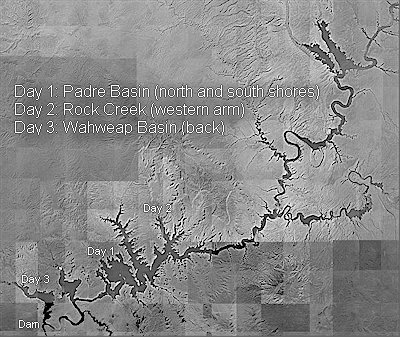
Lake Powell, Utah where we tested Sebile's hard baits.
Our third day (Nov, 12th), we could not repeat
the pattern (find sufficient shad in the brush) - at least not in
the spots we tried the third day. We stayed in Wahweap basin the
third day, which was our least productive day. We failed to find
shad in the brush in the areas we checked in Wahweap basin.
However, there were fair numbers of small bass in those places
anyway (just little or no shad), and we both dumped what felt
like they could have been decent bass that day, so it was still
fun.
Since he has his own hard bait product line, we
decided to fish solely Sebile hard baits for the duration. I
decided to rule out deep water fishing for this trip. With the
limited time we had to put Patrick's hard bait product line
through the paces, I elected to forego deeper water and instead
concentrated on the backs of creeks for most of our three days
together. This is because the shallower depths in the backs of
the creeks enabled us have fun with a wider range of Patrick's
product line which includes hard plastic topwaters, jerkbaits,
minnows, stickbaits, crankbaits, lipless cranks and
double-jointed swimbaits.
We did not get anything too big, but there was
certainly enough action to keep us on our toes for the entire
three day trip, particularly the first two days.
Several sizes and depths of Sebile's Flatt Shad
lipless crankbait proved best for the duration:
At first we fished the Flatt Shads on normal
retrieves, which proved productive. A few times, however, reeling
in quickly at the end of the cast, we observed some followers and
flashers reacting to the quick pace. So we began to burn the
Flatt Shads by reeling rapidly, and fish began to react and chase
instinctively. We further modified our approach to whipping the
Flatt Shads by sweeping the rod tip quickly up from water level
to say 11 o'clock, pausing slightly at the top of the sweep, and
then reeling in the slack on the downstroke as we lowered the
rods to whip again. The whipping tactic gave us the fast lure
movement on the upstroke that caused the instinctive chasing -
plus a falling hesitation each time we reeled down to match the
sinking Flatt Shad's fall on the downstroke. This whipping tactic
proved most productive of all.
Other Sebile hard baits that landed plenty of
stripers, largemouth and smallmouth for us were:
-
Koolie Minnow and Acast Minnow in several lengths
and lip sizes, worked with jerk-and-pause retrieves as well as
trolling long lip models in 25-35 feet of water
-
Slim Stick topwater walking baits in 98 and 118
sizes
-
Stick Shadd 72 SK, 90 SK and 90 FT hard plastic
stickbaits in floating and sinking models
-
Double-jointed Magic Swimmer 95 SSK, 125 SSK and
110 FSK models
-
Crankster 65 MR medium-running fat-bodied
crankbait
-
Rattsler flat-sided crankbaits
-
Proppler Buzz buzzbaits in the very thickest of
heavy brush
It was strictly a Sebile hard bait outing for us
as we elected not to try other brands or styles of baits.
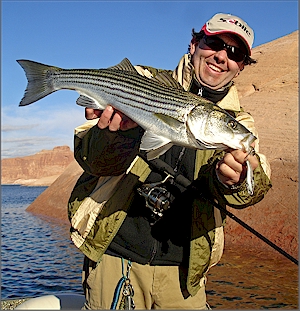
Fish caught on Flatt Shad 66 XH (extra heavy) lipless

Caught on Koolie Minnow 90 SL (short lip) suspending jerkbait
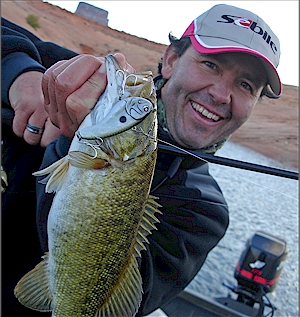
Caught on Flatt Shad 66 XH (extra heavy sinking) lipless. Holo
Greenie color matched shad color.
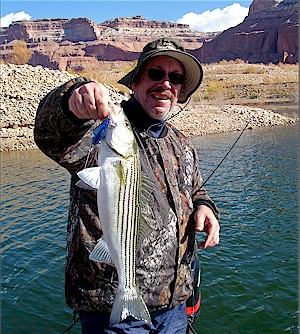
Caught on Flatt Shad 66 SK (sinking).
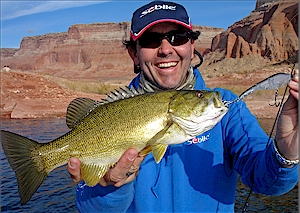
Landed on Magic Swimmer 110 FSK (fast sinking).
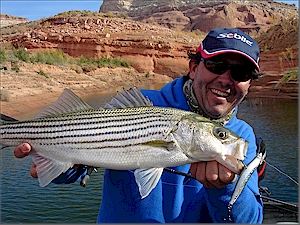
Caught on Slim Stick 118 topwater walking stickbait.
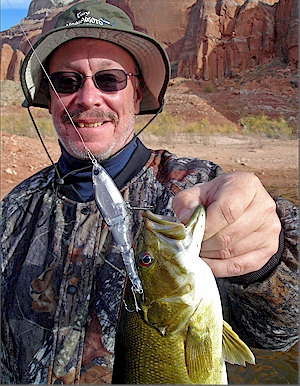
Another caught on triple-jointed Magic Swimmer 110 FSK (fast
sinking).
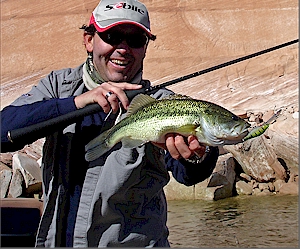
Beauty bested by Rattsler 85 VLL (very long lip) flat-sided
crank.
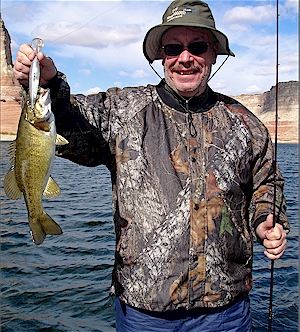
Caught trolling 35 feet deep with Koolie Minnow 118 LL (long
lip).
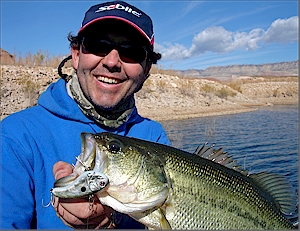
Flatt Shads in 54 SK, 66 SK, 66 XH (shown here) and 77 SU with a
whipping retrieve were the best producers this trip.
